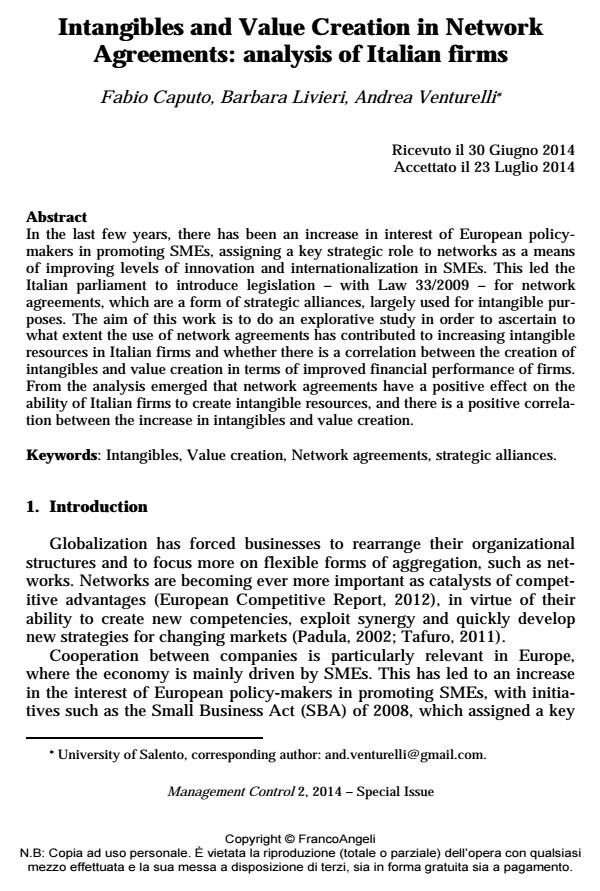Intangibles and Value Creation in Network Agreements: analysis of Italian firms
Titolo Rivista MANAGEMENT CONTROL
Autori/Curatori Fabio Caputo, Barbara Livieri, Andrea Venturelli
Anno di pubblicazione 2014 Fascicolo 2014/2
Lingua Inglese Numero pagine 26 P. 45-70 Dimensione file 165 KB
DOI 10.3280/MACO2014-002003
Il DOI è il codice a barre della proprietà intellettuale: per saperne di più
clicca qui
Qui sotto puoi vedere in anteprima la prima pagina di questo articolo.
Se questo articolo ti interessa, lo puoi acquistare (e scaricare in formato pdf) seguendo le facili indicazioni per acquistare il download credit. Acquista Download Credits per scaricare questo Articolo in formato PDF

FrancoAngeli è membro della Publishers International Linking Association, Inc (PILA)associazione indipendente e non profit per facilitare (attraverso i servizi tecnologici implementati da CrossRef.org) l’accesso degli studiosi ai contenuti digitali nelle pubblicazioni professionali e scientifiche
In the last few years, there has been an increase in interest of European policymakers in promoting SMEs, assigning a key strategic role to networks as a means of improving levels of innovation and internationalization in SMEs. This led the Italian parliament to introduce legislation - with Law 33/2009 - for network agreements, which are a form of strategic alliances, largely used for intangible purposes. The aim of this work is to do an explorative study in order to ascertain to what extent the use of network agreements has contributed to increasing intangible resources in Italian firms and whether there is a correlation between the creation of intangibles and value creation in terms of improved financial performance of firms. From the analysis emerged that network agreements have a positive effect on the ability of Italian firms to create intangible resources, and there is a positive correlation between the increase in intangibles and value creation.
Parole chiave:Intangibles, Value creation, Network agreements, strategic alliances.
- Gender diversity and online intellectual capital disclosure: Evidence from Italian‐listed firms Giuseppe Nicolò, Giuseppe Sannino, Serena De Iorio, in Journal of Public Affairs e2706/2022
DOI: 10.1002/pa.2706 - La Network Governance a supporto dell'Open Innovation: un'analisi della letteratura Palmira Piedepalumbo, Concetta Metallo, Daniela Mancini, in MANAGEMENT CONTROL 3/2017 pp.79
DOI: 10.3280/MACO2017-003006 - Agglomeration, Structural Embeddedness, and Enterprises’ Innovation Performance: An Empirical Study of Wuhan Biopharmaceutical Industrial Cluster Network Jingjing Zeng, Dingjie Liu, Hongtao Yi, in Sustainability /2019 pp.3922
DOI: 10.3390/su11143922 - Measuring intellectual capital in a firm belonging to a strategic alliance Stefania Veltri, Andrea Venturelli, Giovanni Mastroleo, in Journal of Intellectual Capital /2015 pp.174
DOI: 10.1108/JIC-06-2014-0069 - Accounting Information Systems in an Open Society. Emerging Trends and Issues Daniela Mancini, in MANAGEMENT CONTROL 1/2016 pp.5
DOI: 10.3280/MACO2016-001001 - L'impatto del contratto di rete nei processi di internazionalizzazione: alcune evidenze empiriche sulle PMI italiane Andrea Venturelli, Fabio Caputo, Simone Pizzi, in MANAGEMENT CONTROL 2/2018 pp.61
DOI: 10.3280/MACO2018-002004 - The Relationship among Family Business, Corporate Governance, and Firm Performance: An Empirical Assessment in the Tourism Sector Rossella Leopizzi, Simone Pizzi, Fabrizio D'Addario, in Administrative Sciences /2021 pp.8
DOI: 10.3390/admsci11010008
Fabio Caputo, Barbara Livieri, Andrea Venturelli, Intangibles and Value Creation in Network Agreements: analysis of Italian firms in "MANAGEMENT CONTROL" 2/2014, pp 45-70, DOI: 10.3280/MACO2014-002003